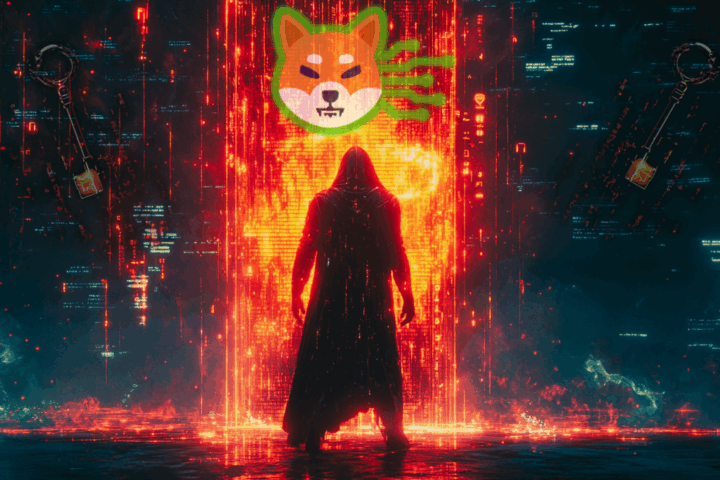In the latest twist in U.S. presidential race dynamics, Robert Kennedy Jr. (RFK), in a bold departure from conventional U.S. presidential campaign promises, has introduced a transformative proposal that could redefine federal financial management: shifting the entire U.S. budget to blockchain technology.
Touted as a leap toward unparalleled transparency and operational efficiency, this visionary proposal has ignited a mix of cautious optimism and sharp skepticism across the political spectrum.
The Shib Daily sought the help of a leading Web3 expert to examine the potential implementation of JFK Jr’s proposal. That deep dive threw up a raft of troubling questions, quickly evaporating any exhilaration the proposal may have created: Is this a breakthrough for government accountability, or a complex and lengthy technological entanglement waiting to unfold?
A Visionary Proposal
Last weekend, independent presidential candidate Kennedy expressed his intention to revolutionize how governmental budgets are managed. During a rally in Michigan, he boldly declared, “I’m going to put the entire U.S. budget on [the] blockchain so that any American — every American can look at every budget item in the entire budget anytime they want 24 hours a day.”
The promise of such transparency aims to revolutionize how taxpayer funds are allocated and scrutinized, potentially enhancing both transparency and accountability within government operations. Yet, the challenge of transitioning to a blockchain-based system is formidable, involving complex technological and security considerations.
Expert Insight: Feasibility and Security Challenges
To delve deeper into these complexities, The Shib Daily engaged with Hacken, a globally recognized blockchain security auditor dedicated to enhancing Web3 security. Luciano Ciattaglia, director of services at Hacken, provided expert insights into the technical and security challenges thrown up by Kennedy’s proposal.
“To make this idea a reality (without resorting to makeshift solutions and the use of conditional stablecoins), we will need to implement CBDC (Central Bank Digital Currency) one way or another. A CBDC would inherently utilize blockchain or similar ledger technology, which ensures that financial transactions are recorded transparently and immutably,” Ciattaglia explained.
This integration, according to Ciattaglia, would not only streamline the recording of tax transactions but also simplify the tracing and auditing of public funds, thereby enhancing government operation transparency. However the technology to support this scale of financial management is daunting. “Frameworks like Hyperledger and Corda represent the type of enterprise-grade, permissioned blockchain platforms that could handle such tasks,” he noted, though he quickly added a caveat: “However, we’re talking about managing a federal budget that amounts to $3.25 trillion. No current blockchain framework has been tested with this volume of transactions.”
Over a year ago, Kennedy voiced strong concerns about CBDCs, highlighting the potential privacy issues they could introduce. He emphasized that unlike cash transactions, which are anonymous, CBDCs could enable unprecedented government surveillance of private financial activities. Kennedy criticized the power CBDCs would grant central banks to impose restrictions on transactions, including limitations on amounts, destinations, specific uses, and even the timing of money expiry, underscoring a significant shift from current financial freedoms.
In March last year, Federal Reserve Chairman Jerome Powell said the Fed has has made no decision on issuing a CBDC, adding it’s “something we would certainly need Congressional approval for.”
Navigating the Security Minefield
The conversation then shifted to security—a critical component if one were to consider overhauling the financial backbone of the world’s largest economy. “We would need a bulletproof system, secured by sufficiently decentralized nodes to prevent national security compromises,” stated Ciattaglia. He underscored the importance of continuous security audits and pentesting to maintain integrity across all system layers.
Yet, the implementation of such a monumental system isn’t just about setting up defenses against hacks and unauthorized access. It also involves addressing inherent risks such as data manipulation and ensuring the public’s trust in this new method of transaction recording.
The potential benefits of such a blockchain-based system are clear: unparalleled transparency and the reduction of manual intervention via automation, smart contracts, and decentralized applications. These changes could lead to significant improvements in cost efficiency, accuracy, and accountability in managing public records and financial administration.
In terms of security requirements for an initiative of this size, Hacken said three key areas must be addressed first. These are:
- Tamper-proof records – enhanced security against data manipulation and fraud.
- Trust in transactions – public confidence in the integrity of operations.
- Data privacy – ensuring the confidentiality and accuracy of sensitive information.
In addressing the potential security threats associated with a blockchain-based budget system, such as hacking or unauthorized access, Ciattaglia outlined a robust strategy. The key to mitigating these risks involves:
- Designing a bulletproof system with sufficiently decentralized nodes that don’t compromise national security.
- Thorough security audits and pentesting to ensure the integrity of all layers of this blockchain-based system.
- Allocating sufficient time and funding for independent audits and feedback from security experts.
Potential Benefits and Drawbacks
The benefits of such a system are clear: enhanced transparency could lead to greater accountability and efficiency in public spending, driven by automation and smart contracts that reduce manual intervention. Yet, Ciattaglia cautioned that while blockchain provides transparency, it does not necessarily address deeper issues such as corruption or misuse of funds.
“The obvious advantage of such a currency system is total transparency. Another benefit is efficiency. Automation enabled by smart contracts or decentralized applications reduces manual intervention and enhances cost efficiency, accuracy, and accountability for public records management and financial administration,” Ciattaglia explained.
Addressing the potential drawbacks of centralizing critical financial data on a blockchain platform, the Hacken executive highlighted several significant risks and negative implications. “While blockchain technology offers transparency, it may exacerbate existing issues rather than solve them. The transparency provided by blockchain may not effectively combat corruption or misuse of funds – you know where the money goes but don’t know if it’s wasted. While taxpayers can see where their money is allocated, it doesn’t necessarily address deeper issues such as nepotism or favoritism in government contracts. The challenge lies in identifying the connections between businesses and individuals, which blockchain alone may not accomplish,” Ciattaglia said.
“Moreover, the total transparency afforded by blockchain also means that all citizens’ financial activities can be monitored. This level of surveillance could lead to a dystopian scenario where non-standard spending behavior triggers notifications or scrutiny from monitoring systems,” he added.
The flip side of the proposed initiative by RFK Jr. is the risk of creating a system that, while transparent, might not address deeper systemic issues like corruption. Moreover, the very transparency that blockchain brings can also heighten concerns over privacy, with a dystopian surveillance scenario where every citizen’s financial activity is monitored and scrutinized.
A Complex, Lengthy Road Ahead
Implementing Kennedy Jr’s blockchain-based budget system would require a comprehensive and methodical approach, beginning with legislative changes and extensive technological development. The project could span several years, if not a decade, emphasizing the ambitious nature of the proposal and the substantial hurdles it faces.
The process would begin with legislative and regulatory approvals, which are often lengthy due to the need for comprehensive debates, amendments, and eventual ratification across various governmental bodies. Simultaneously, the technological development and rigorous testing of a suitable blockchain infrastructure would need to be undertaken.
This infrastructure would have to be capable of handling the extensive scale and security requirements of the U.S. budget. Integration with existing financial and government systems and the migration of data to the new blockchain system would be a complex phase, requiring meticulous planning to avoid disruptions in government operations. Additionally, training government personnel and ensuring that all stakeholders are adept at using the new system would also consume significant time.
Given these extensive requirements, a conservative estimate for the complete implementation of such a system could range from several years to potentially a decade. Initial stages such as planning, prototyping, and securing legislative support could take approximately 2-3 years, with additional years required for phased roll-outs and system optimizations. Therefore, even with immediate action following an election, the project would likely span multiple years, emphasizing the ambitious nature of Kennedy Jr’s proposal and the methodical, phased approach required to bring it to fruition.
As RFK’s proposal stirs debate, it becomes evident that the path to implementing such a system would be fraught with challenges—both technological and ethical. The discussion with Ciattaglia revealed that while the technological infrastructure might eventually be built, the broader implications of such a system need careful consideration. This initiative could either streamline and sanctify government transactions or entangle them in new controversies and complexities.
Read More
- A Bullish Forecast: SHIB to Reach $100B Market Cap by 2025
- Shibarium Network Hard Fork Update: Faster, Cheaper, and Ready for the Future
- SHIB Ecosystem Dominates: Q1 Rally Elevates Shiba Inu, LEASH And BONE
Yona has no crypto positions and does not hold any crypto assets. This article is provided for informational purposes only and should not be construed as financial advice. The Shib Daily is an official media and publication of the Shiba Inu cryptocurrency project. Readers are encouraged to conduct their own research and consult with a qualified financial adviser before making any investment decisions.










